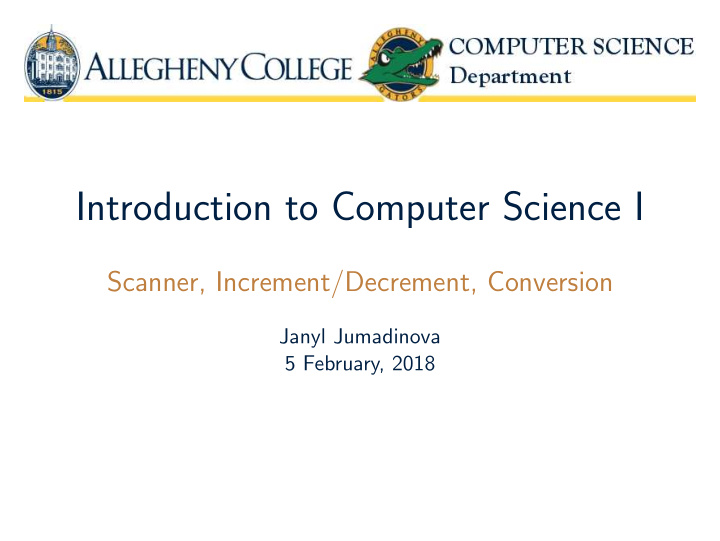



Introduction to Computer Science I Scanner, Increment/Decrement, Conversion Janyl Jumadinova 5 February, 2018
Review: Scanner ◮ The Scanner class in the java.util package is a simple text scanner which can parse primitive types and strings ◮ We can use the Scanner class to get the input from the terminal ◮ We must create an instance of the Scanner as: Scanner name = new Scanner (System.in) where name is the name you choose for your instance of the Scanner 2/11
Scanner Methods ◮ next() : get the next word (token) as a String ◮ nextLine() : get a line of input as a String ◮ nextInt() : get an integer ◮ nextDouble() : get a double value 3/11
Memory Concepts ◮ Variable names such as first, second and sum correspond to locations in the computer’s memory. 4/11
Memory Concepts ◮ Variable names such as first, second and sum correspond to locations in the computer’s memory. ◮ Every variable has: - a name, - a type, - a size, - a value 4/11
Memory Concepts ◮ Variable names such as first, second and sum correspond to locations in the computer’s memory. ◮ Every variable has: - a name, - a type, - a size, - a value ◮ first = input.nextInt(); stores whatever the user types into the location associated with first . 4/11
Memory Concepts ◮ Whenever a value is placed in a memory location, it replaces whatever was there before. ◮ This includes keyboard input (such as first = input.nextInt() ) and assignment statements (such as sum = first + second ). 5/11
Conversion ◮ Widening - from byte to short, int, long, float or double - from short to int, long, float, double - from char to int, long, float, double - from int to long, float, double - from long to float, double - from float to double 6/11
Conversion ◮ Narrowing - should be avoided! - from byte to char - from short to byte, char - from char to byte, short - from int to byte, short, char - from long to byte, short, char, int - from float to byte, short, char, int, long - from double to byte, short, char, int, long, float 7/11
Conversion ◮ Assignment: grade = ‘A’ ◮ Promotion: total/count , where total is a floating point value and count is an integer - Occurs automatically, count is promoted to a floating point value ◮ Casting: grade = (int) total - Java operator: type name in parentheses - Casting converts floating point value total into an integer, truncating any fractional part. 8/11
Increment and Decrement Operators ◮ ++: adds 1 to any value count ++ same as count=count+1 prefix form: ++count postfix form: count++ ◮ -- : subtracts 1 from any value count -- same as count=count-1 prefix form: --count postfix form: count-- 9/11
Increment and Decrement Operators ◮ ++: adds 1 to any value count ++ same as count=count+1 prefix form: ++count postfix form: count++ ◮ -- : subtracts 1 from any value count -- same as count=count-1 prefix form: --count postfix form: count-- ◮ total = count ++; vs. total = ++count; 9/11
Increment and Decrement Operators ◮ += (-=, *=, ..): combine basic operation with assignment count += num same as count=count+num 10/11
Google Style Exercise and Directory Organization Google Java Style Guide 11/11
Recommend
More recommend